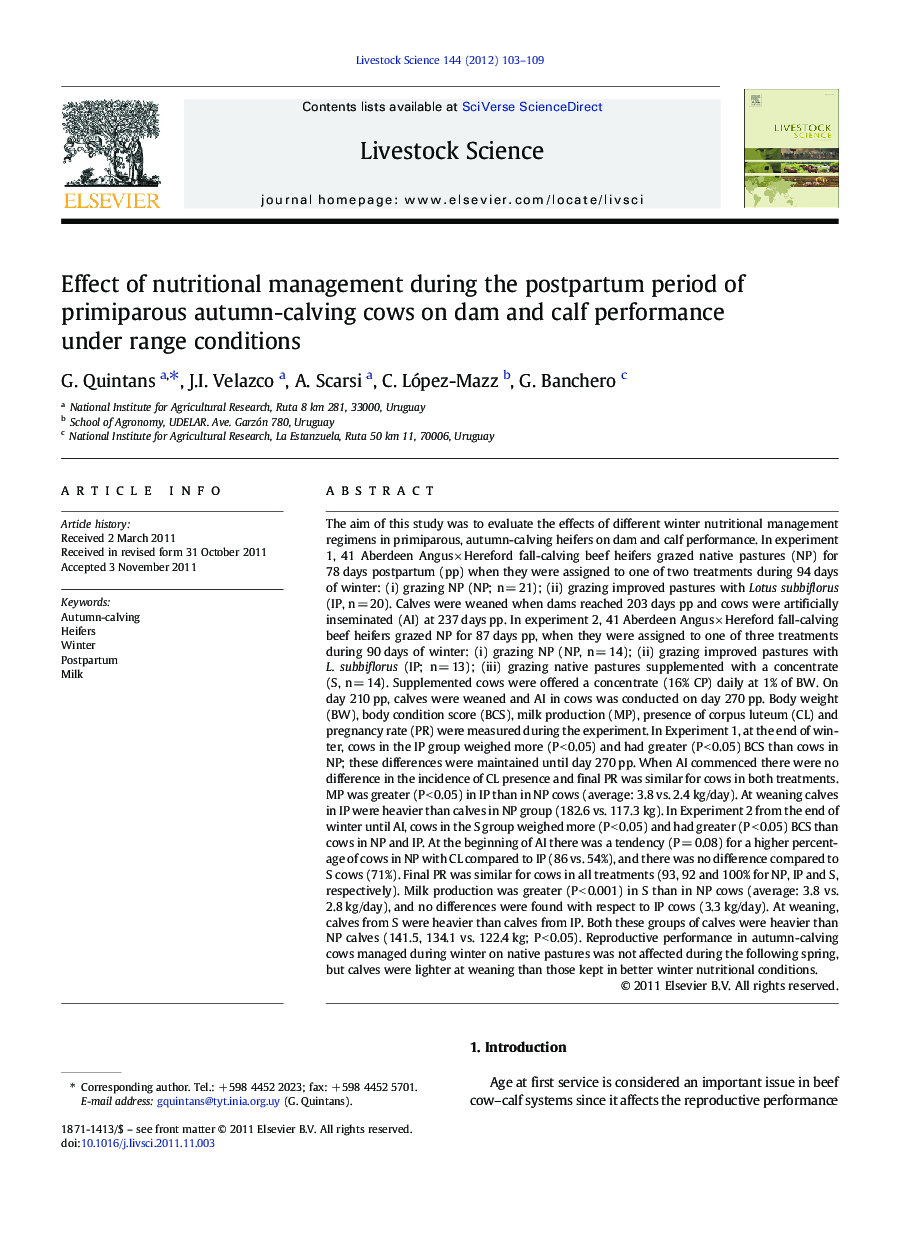| کد مقاله | کد نشریه | سال انتشار | مقاله انگلیسی | نسخه تمام متن |
|---|---|---|---|---|
| 5790931 | 1553988 | 2012 | 7 صفحه PDF | دانلود رایگان |

The aim of this study was to evaluate the effects of different winter nutritional management regimens in primiparous, autumn-calving heifers on dam and calf performance. In experiment 1, 41 Aberdeen Angus Ã Hereford fall-calving beef heifers grazed native pastures (NP) for 78 days postpartum (pp) when they were assigned to one of two treatments during 94 days of winter: (i) grazing NP (NP; n = 21); (ii) grazing improved pastures with Lotus subbiflorus (IP, n = 20). Calves were weaned when dams reached 203 days pp and cows were artificially inseminated (AI) at 237 days pp. In experiment 2, 41 Aberdeen Angus Ã Hereford fall-calving beef heifers grazed NP for 87 days pp, when they were assigned to one of three treatments during 90 days of winter: (i) grazing NP (NP, n = 14); (ii) grazing improved pastures with L. subbiflorus (IP; n = 13); (iii) grazing native pastures supplemented with a concentrate (S, n = 14). Supplemented cows were offered a concentrate (16% CP) daily at 1% of BW. On day 210 pp, calves were weaned and AI in cows was conducted on day 270 pp. Body weight (BW), body condition score (BCS), milk production (MP), presence of corpus luteum (CL) and pregnancy rate (PR) were measured during the experiment. In Experiment 1, at the end of winter, cows in the IP group weighed more (P < 0.05) and had greater (P < 0.05) BCS than cows in NP; these differences were maintained until day 270 pp. When AI commenced there were no difference in the incidence of CL presence and final PR was similar for cows in both treatments. MP was greater (P < 0.05) in IP than in NP cows (average: 3.8 vs. 2.4 kg/day). At weaning calves in IP were heavier than calves in NP group (182.6 vs. 117.3 kg). In Experiment 2 from the end of winter until AI, cows in the S group weighed more (P < 0.05) and had greater (P < 0.05) BCS than cows in NP and IP. At the beginning of AI there was a tendency (P = 0.08) for a higher percentage of cows in NP with CL compared to IP (86 vs. 54%), and there was no difference compared to S cows (71%). Final PR was similar for cows in all treatments (93, 92 and 100% for NP, IP and S, respectively). Milk production was greater (P < 0.001) in S than in NP cows (average: 3.8 vs. 2.8 kg/day), and no differences were found with respect to IP cows (3.3 kg/day). At weaning, calves from S were heavier than calves from IP. Both these groups of calves were heavier than NP calves (141.5, 134.1 vs. 122.4 kg; P < 0.05). Reproductive performance in autumn-calving cows managed during winter on native pastures was not affected during the following spring, but calves were lighter at weaning than those kept in better winter nutritional conditions.
Journal: Livestock Science - Volume 144, Issues 1â2, March 2012, Pages 103-109